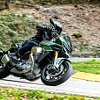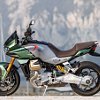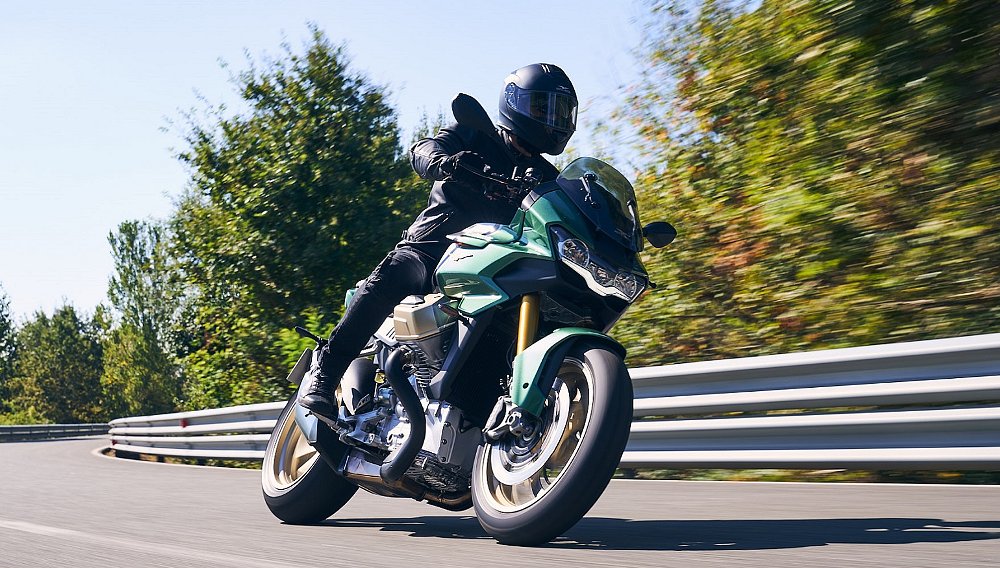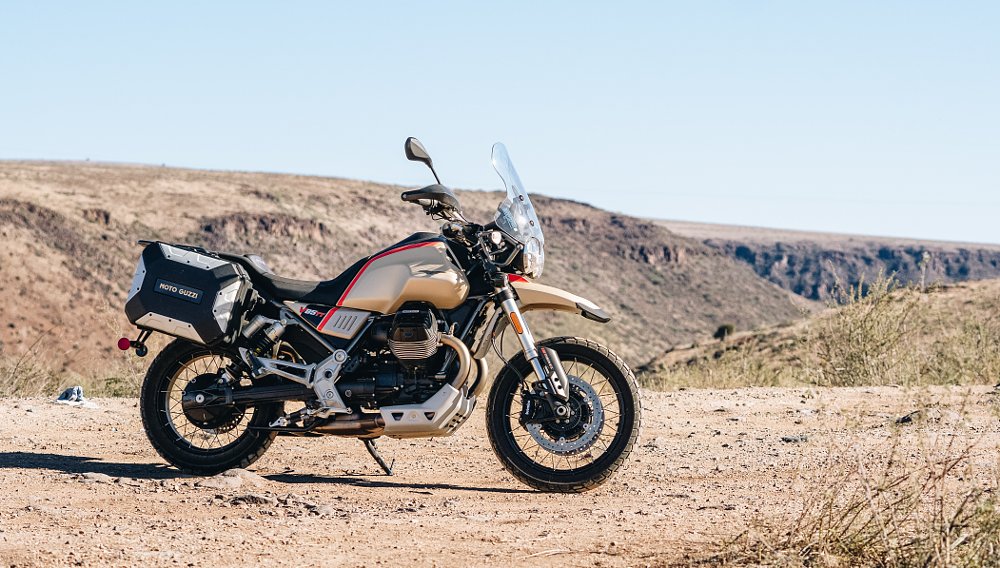The first adaptive aero on a production motorcycle. An all-new, liquid-cooled engine. A fully modern tech package including semi-active suspension and an IMU. Roadster performance with touring capability. Moto Guzzi is swinging for the fences with its new V100 Mandello.
If we look at the brand’s recent history, Moto Guzzi’s lineup was limited to V7/V9 standards and a handful of baroque cruisers. These 90-degree, air-cooled flying Vs stayed true to a century of Moto Guzzi tradition, maybe too true, while other European manufacturers moved on. That started to change with the arrival of the V85 TT adventurer, a surprising and attractive bike that became one of Common Tread’s favorite motorcycles of 2019. Something had changed at MG.

And now, four years later, comes an uncommonly fresh model that is unlike anything Moto Guzzi has ever built before. It’s available in two variants: the base V100 Mandello ($15,490) or the V100 Mandello S ($17,490) that adds semi-active suspension, fancy paint, a quickshifter, heated grips, TPMS, and the MIA smartphone connectivity system. So… what is this motorcycle, exactly?

The V100 Mandello is positioned as forward-thinking “all-rounder” for the street. It has 17-inch sport wheels, a reasonably large fuel capacity, and a full-size seat to accommodate a passenger or some cargo. The front half-fairing design is practical and attractive. Integrated cutouts in the tail section accept Moto Guzzi’s accessory luggage. (Capacity is 59 liters combined for the side cases, and 37 liters for the top box, which requires an accessory rack.) Based on my short time with this motorcycle, I think it could handle commuting, sport-touring, and spirited riding equally well. The Europeans have always been keener on this kind of motorcycle than the U.S. riding population, but tastes are shifting, and Moto Guzzi wants to kick off a new era in style.

Engine and performance
If we follow Moto Guzzi’s traditional model naming rules, a V100 should be a liter-class engine. That’s exactly what the Mandello offers — a 1,042 cc transverse V-twin producing a claimed 115 horsepower at 8,700 rpm and 77.5 foot-pounds of torque at 6,750 rpm. The biggest change with this entirely new engine is the addition of liquid cooling. BMW, Ducati, and Triumph all transitioned legacy engine layouts into the 21st century, so why not MG?
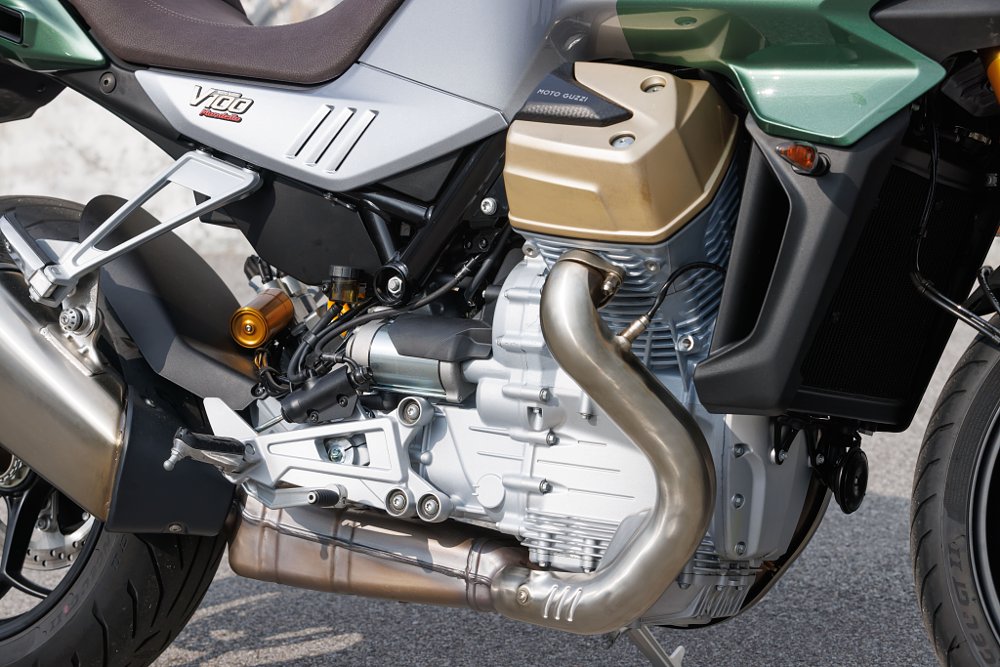
The “compact block” engine does not deviate from Moto Guzzi’s most sacred rule of engine design. 90 degrees separate the two cylinders. Beyond that, everything is completely new, and the V100 “does not share even one component with previous engines built in Mandello.”
A counter-rotating crankshaft helps to quell some of the Guzzi “roll” when cracking the throttle, not unlike the arrangement used by Honda in the CX500. The V100 mill has dual overhead cams for each bank, four valves per cylinder, and finger followers. The bore is 96 mm with a 72 mm stroke. The foot pegs are mounted to the crankcases with rubber isolators and beefy brackets. Overall dimensions are four inches shorter than the V85 TT’s short block and lighter than any eight-valver in the marque’s history. The alternator now sits between the cylinders’ V, and the throttle bodies are tucked above it. The cylinder heads have been rotated 90 degrees from the standard Guzzi position to facilitate the cam chain drive mechanism. This also increases legroom. Claimed fuel economy for the new engine is 50 miles per gallon.
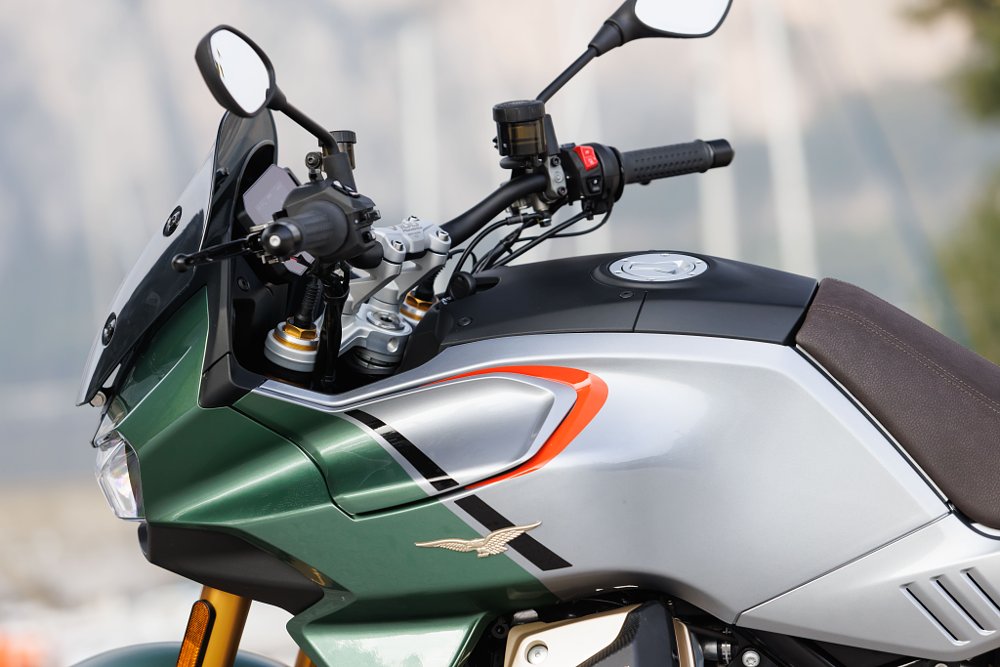
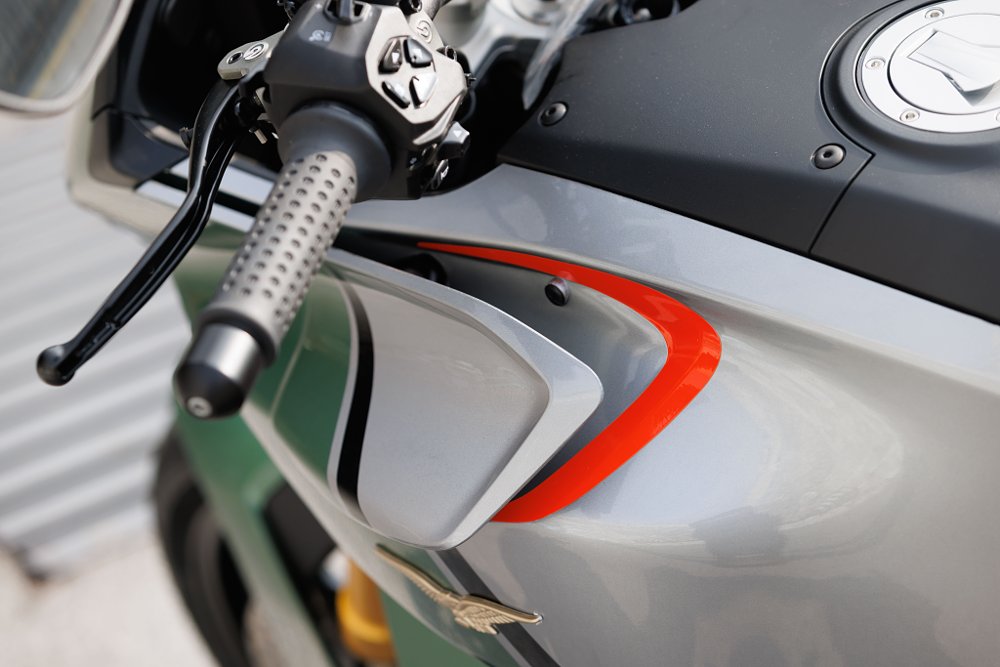
Frame, wheels, and suspension
The tidy steel tubular frame uses the engine as a stressed member. The engine’s position makes the bike feel like weight is biased towards the front wheel, although that might easily change with a tour’s worth of luggage, a passenger, and/or a rider weighing more than me. (For reference, I weigh 165 pounds, or maybe closer to 170 after all the pasta, fish, and cheese I ate in Italy.)

The “tank” covers the throttle bodies, airbox, and part of the actual gas tank that protrudes under the seat for better weight distribution. (Between electric motorcycles not needing gas tanks, and many ICE motorcycles moving to underseat designs, are we witnessing the final days of the real gas tank?)
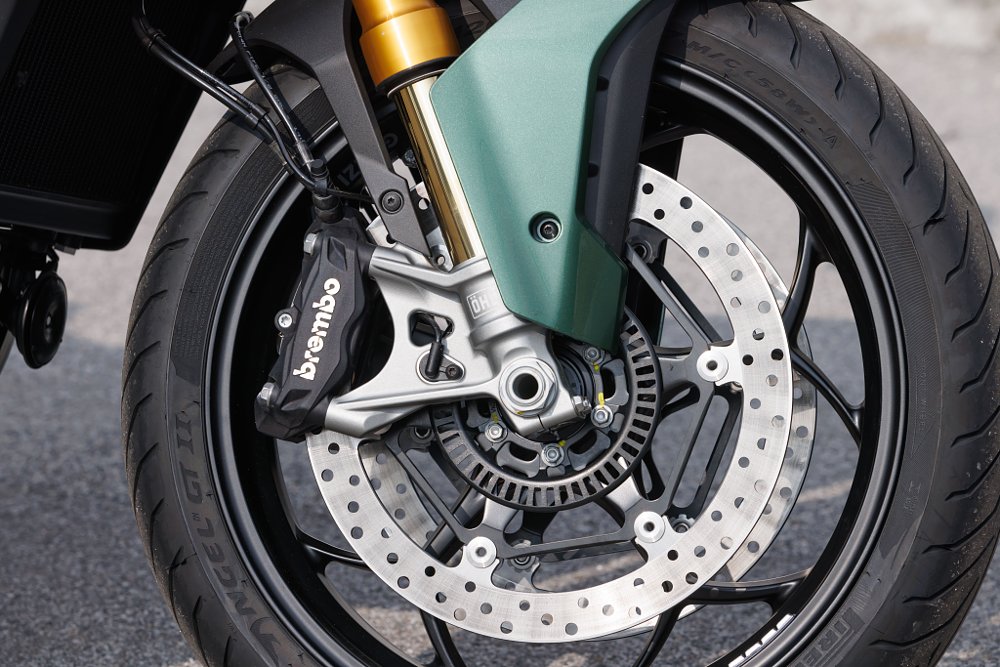
The base Mandello wears a slightly smaller Kayaba fork with adjustability for preload and rebound. The Mandello S gets Öhlins’ Smart EC 2.0 semi-active suspension, so if you’re a set-it-and-forget-it kind of rider, the base model will be worth a look for a $2,000 price difference. Turning back to the Öhlins’ kit, this suspension constantly monitors and adapts to sensor feedback to deliver optimal performance. Ride modes (Tour, Rain, Road, and Sport) can make broad changes to ride feel, and each mode can be further tailored by the rider using the fine adjustments menu. Suspension performance is only limited by the amount of time you’d like to spend refining it.

Moving to the rear of the bike, customers will either get a Kayaba shock or Öhlins goodness depending on trim level. One notable chassis development back here for all Mandellos is the addition of a U-joint between the transmission output shaft and the shaft drive. This means the drive shaft doesn’t need to be parallel with the centerline of the bike, or exactly perpendicular to the wheel’s axis of rotation. As a result, the “waist” of the V100 can be narrower, the swingarm can be mounted to the crankcases for reduced “jacking” effect, and the rear wheel can run wider tires… That’s a 190 back there! The swingarm itself is nicely finished and almost sculptural. Has practical shaft drive ever looked this pretty?
Braking is by Brembo for all V100 Mandellos. Radial-mount four-pot calipers bite 320 mm discs up front using a radial Brembo master cylinder, and a twin-pot on a 280 mm disc covers the rear.
Technology, instrumentation, and rider comfort
All of the bike’s features are controlled using the switch pods and the crisp five-inch TFT dash. Aprilia fans might notice that the dash looks familiar, and I think that’s a good thing. Moto Guzzi and Aprilia are both part of Piaggio Group, so MG can lean on Aprilia’s tech expertise instead of starting from scratch. A large button under the kill switch toggles modes. Mode tuning on the dash allows the rider to choose from three engine maps, four traction control levels, high or low engine braking, aero deployment, and for the S version, specific semi-active suspension settings.

By the left grip, there’s a set of directional buttons for navigating menus, cruise control switches, and the usual horn, turn signal, and headlight beam buttons. This is a welcome improvement over the V85 TT that had menu controls on the right side by the throttle.
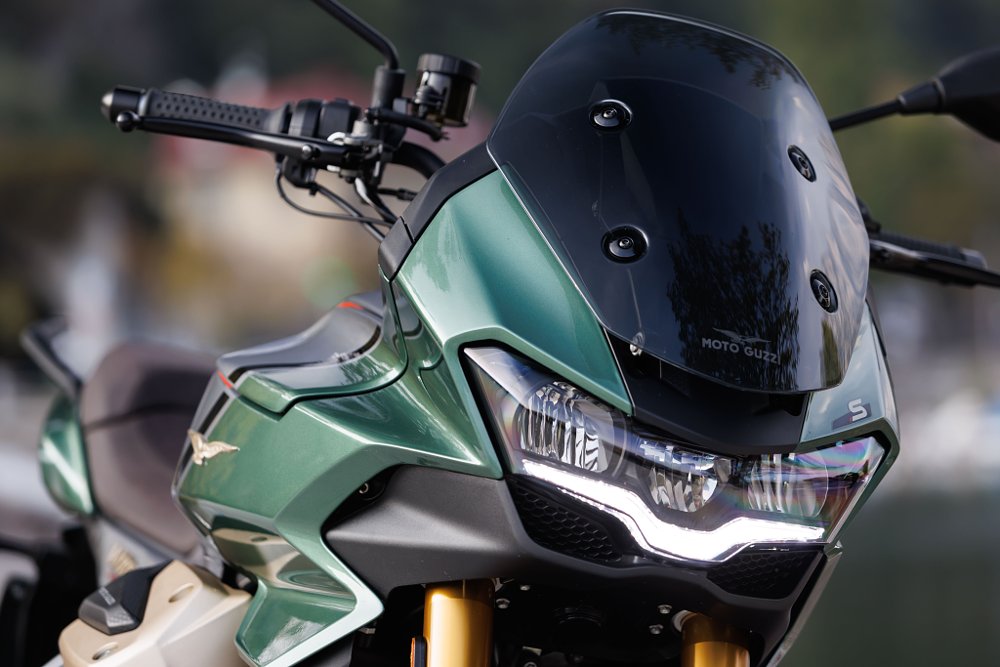
All lights are LED. A DRL “eagle” sits inside the headlight assembly with two round main lights directly behind it. There’s no mistaking this motorcycle for anything else in a rearview mirror. The tail light continues the twin-round motif we saw on the V85 TT. The stylists say these lights are meant to evoke a jet airplane’s afterburners. Moto Guzzi uses sleek micro turn signals that look much better than they perform. Adequate, yes, just not large or bright in daytime. (They are still superior to most low-profile aftermarket turn signals.)
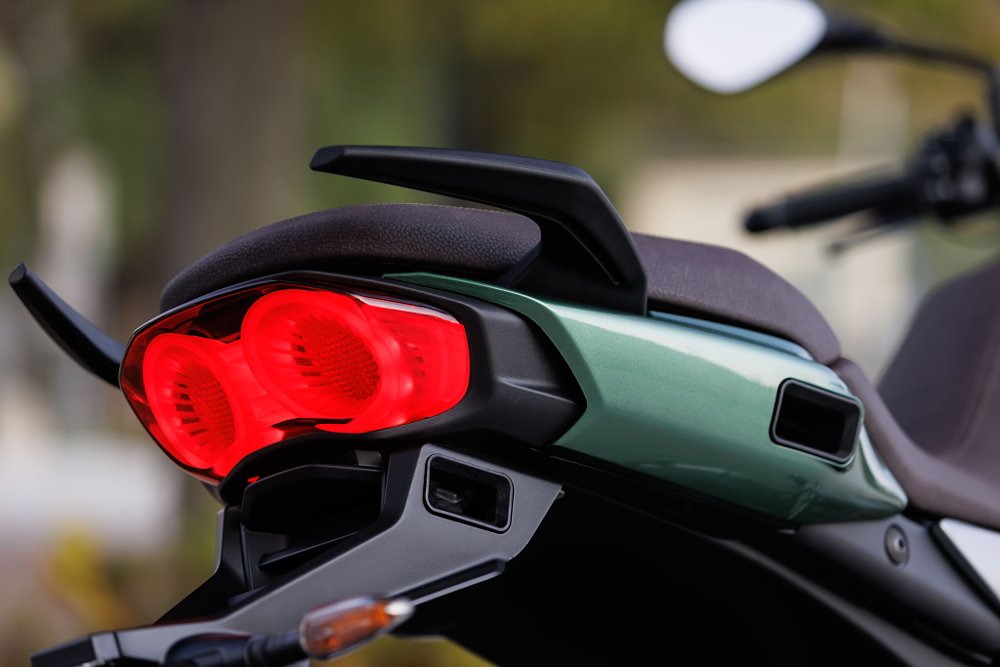
The most intriguing tech feature is the adaptive aero “wings” that deploy once the bike reaches 45 miles per hour in Tour and Road ride modes. Sport mode keeps them closed, and Rain mode leaves them open at all speeds. These flaps are intended to move wind blast and precipitation around the rider for better comfort, not outright speed. Moto Guzzi claims its adaptive aero cuts wind pressure on the rider by some 22 percent. There’s also an electrically adjustable windscreen with several height options in the accessory catalog, so a tour-focused rider could add even more protection with minimal effort.
Other tech notables include a six-axis IMU, cornering ABS, and a quickshifter. The accessory catalog includes engine guards, a center stand, a heated seat, anti-theft, and aux lights. Base models can also be upgraded with the heated grips, MIA connectivity system (navigation, music, calls, etc.), quickshifter, and TPMS found on the S model.
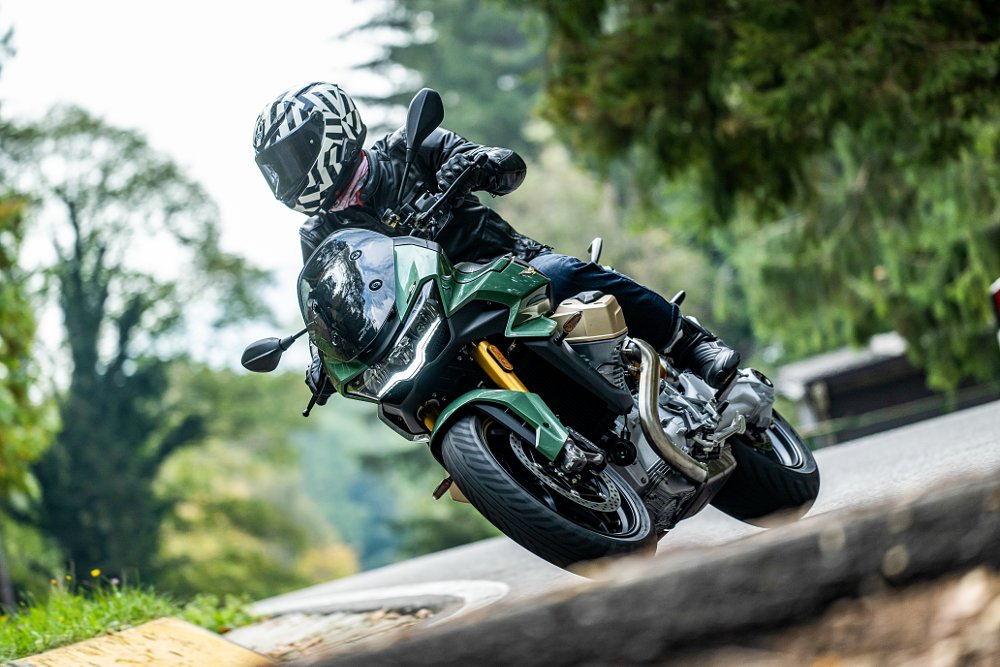
Riding impressions
The V100 Mandello looks much more compact in person than it does in photos. It sits on the same wheelbase as an old Sport 1100, and measures just a hair shorter than a V9 Bobber. The result can be ridden solo with gusto, or comfortably with a passenger. It’s the motorcycling equivalent of an Italian grand touring car. Prod the starter, and it sounds like a quarter of an angry V8. The spec sheet says this motorcycle weighs 514 pounds with the gas tank nearly full. I’d have guessed 25 pounds less than that. At six feet tall with a 32-inch inseam, I had no trouble flat-footing the bike with both feet, and the controls fell nicely to hand.
Setting off on the good ship Mandello, thoughts of compactness can’t overcome the presence of this engine. The reach from the seat to the handlebar is, after all, a reach across the engine below. There’s a shiver at startup reminiscent of the classic Guzzi roll. On the first straightaway, I’m greeted by torque I expected, but a sound I haven’t quite heard before. It’s low, just a little bit lopey with whining overtones and a rorty snap when you get on it. Ah, this will be a good day at work.
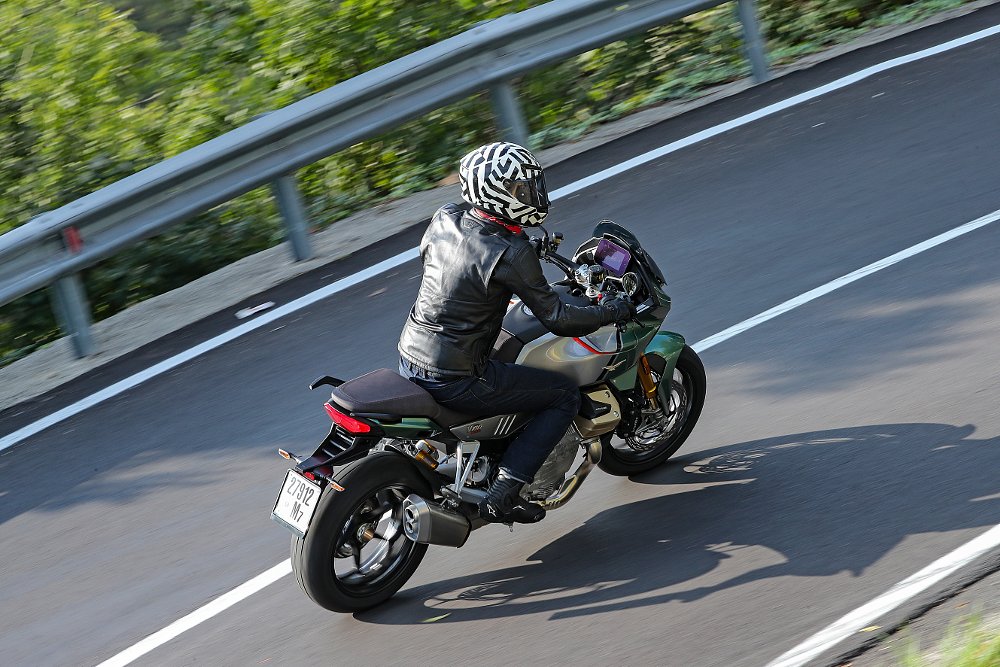
V100 riders will spend most of their time between 3,500 rpm and 8,000 rpm where the power is most flexible. This is not Grandpop’s old Ambassador to be chuff-chuffed from town to town. The exhaust note alone was enough motivation to wind the V100 up and down the tach as I explored the lakeside roads beyond Mandello del Lario.
The substantial front brakes are plenty to haul this good times machine down to a stop. Lever feel and modulation are the usual excellence from Brembo, and any sloppy inputs would be quickly corrected by the bike’s safety systems. No complaints from the rear brake, either. Moto Guzzi recommended that I start in Touring mode before toggling through the others, so I obliged until the roads got tighter. Touring mode relaxes the suspension on the S for a surprisingly comfortable ride. Jab the mode button, and the Öhlins suspension immediately responds with new settings. Technology like this makes a modern sport-tourer incredibly versatile compared to STs of old.
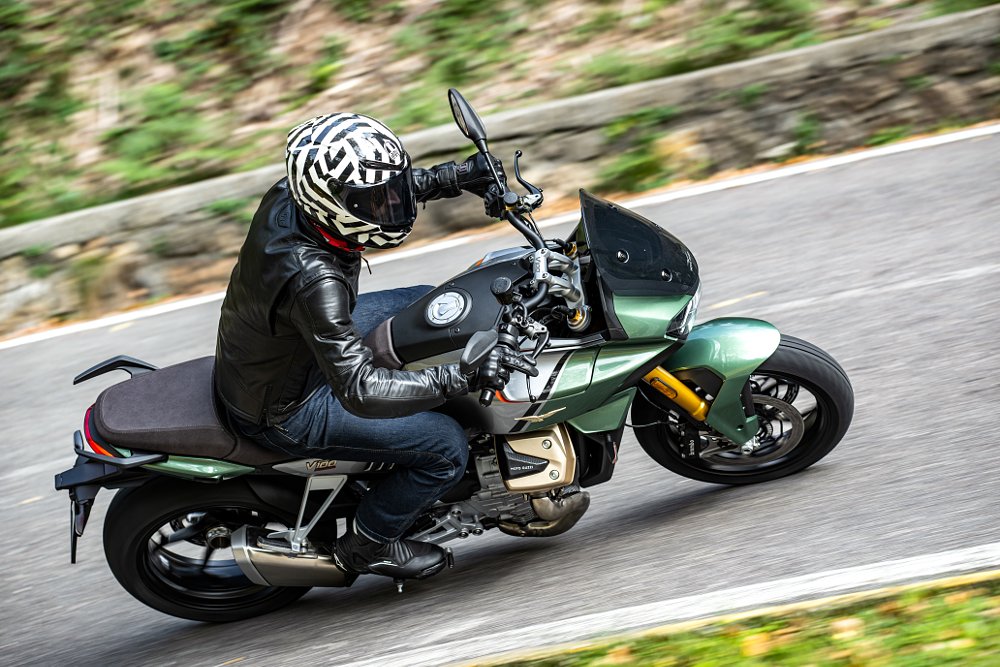
Touring was promptly ditched for Sport mode once the roads got tighter, and I was glad that I didn’t spend any time trying to tune out fork dive. The tauter settings made the bike far sharper in corners. This bike can hustle. A gentle nudge is all that’s needed to tip the Mandello in, and once you’re weaving through successive bends, the heft disappears into the background. The engine’s torquey character makes every corner an opportunity to slingshot yourself out the other side without any roll bias or driveshaft jacking to worry about. In fact, the V100 will happily charge at anything — bends, mountain inclines, on-ramps, overtaking maneuvers — and spit you out hoping for more. Technically, nobody needs an engine of this size even for a two-up tour, but that’s the fun part. It is exactly the right amount of overkill. Sure makes a nice sound in tunnels, too. Hmmm-brrrrrrrtttt-waahhhhh…
Highway testing was sparse between glory roads. While I didn’t see much time above fourth gear all day, fifth and sixth patiently waited for the rare straightaway cruise. If my mental math is right, 3,250 rpm in sixth gear turned 65 miles per hour with plenty on tap. The V100 is quiet and comfortable in the laid-back Touring mode. No complaints from the Department of the Posterior, no buffeting with the windshield up, and utter stability from the chassis. I hoped to feel a little more effect from the adaptive aero here. Most of the wind deflecting seemed to benefit the tops of my legs. I think the wings could make a big difference at speed in the rain, but unfortunately for you readers out there, it was a thoroughly beautiful day in northern Italy and my rain gear never left my bag.
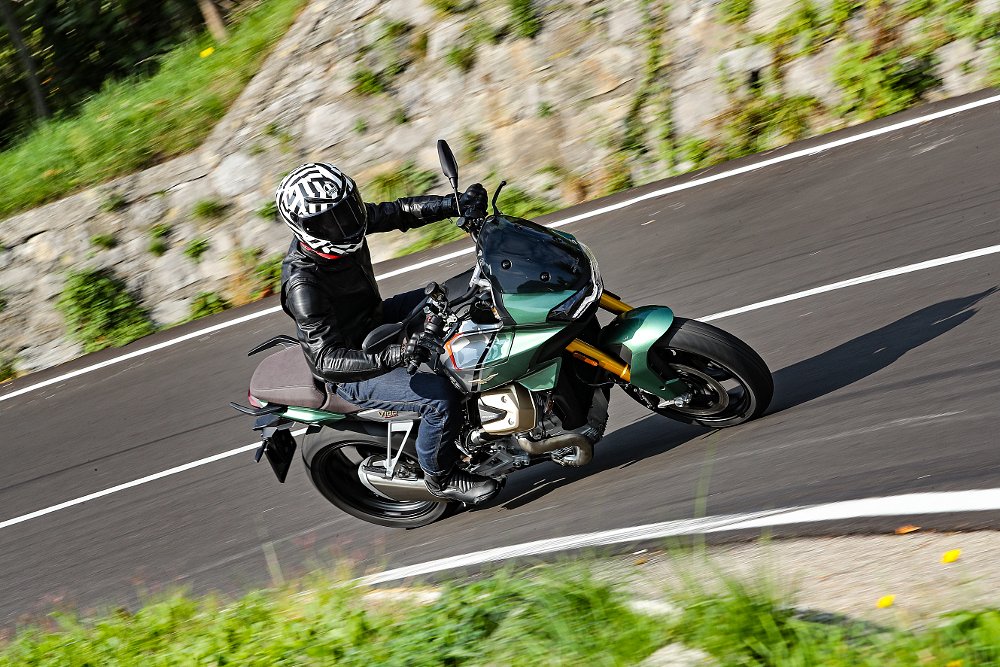
Turning back to the fun roads, I gave Road mode a try, but it didn’t encourage the fun I was looking for. Flipping from plush Touring to Sport was all the Jekyll ‘n’ Hyde action I’d need if I owned this motorcycle, and I’d be perfectly happy if those were the only two modes available. None of the ride modes exhibited dead spots or surging. There’s a tasteful amount of decel burble and a heady top-end rush if you ask for it. This mill blows the V7 and V9 out of the water on everything except strict adherence to tradition, and even there, you’ll have no doubts about the bike’s origin. The frame and suspension keep the bike planted with total confidence. Bombing around mountain roads on the V100 is a joy, and when you consider the bike's touring potential on top of the fun factor, this motorcycle starts to make a lot of sense.
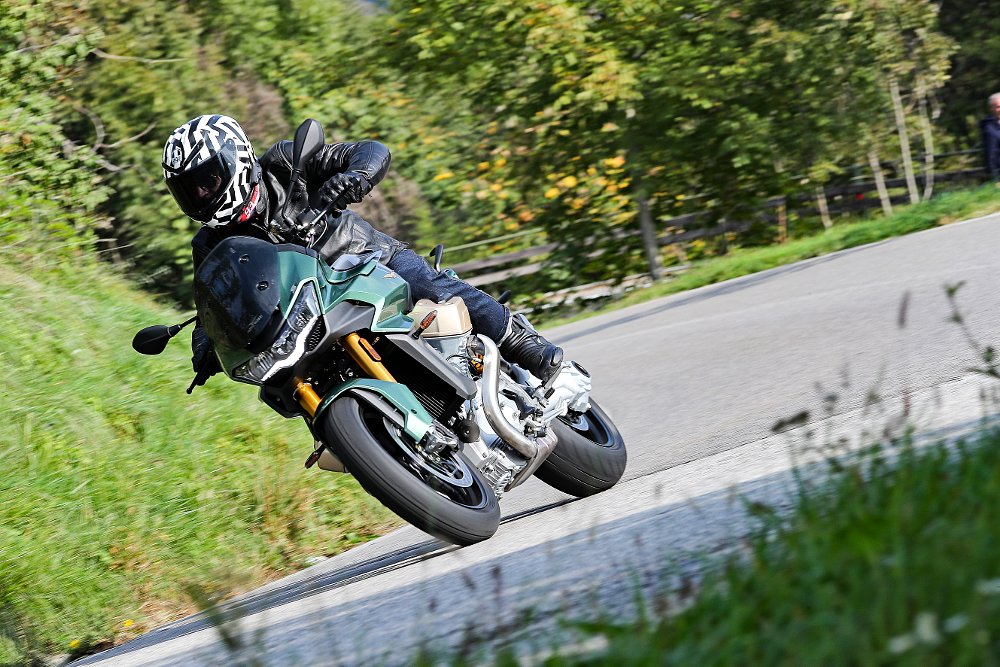
Bravo to Moto Guzzi for reimagining its classic engine architecture into a punchy, aesthetically pleasing new form that is simply fun to ride. As for the motorcycle wrapped around it, the Mandello reminds me of the competent half-faired motorcycles we used to get that all wound up discontinued. Short on compromise, long on versatility, and easy on the eyes. This is a big step for Moto Guzzi and the half-faired class in general.
Suggestions for the next V100
Are there things I’d change about this motorcycle? Absolutely. Are any of them dealbreakers? Not to me. Underseat storage is almost nonexistent. The mode button is easy to bump when using the kill switch, and the turn signal switch feels pretty darn delicate. The menu navigation needs a select button, the quickshifter needs more work, and I’d rather have dedicated buttons for the electric windscreen and heated grips than a submenu. Maybe some of these things will be addressed in the next V100-based model arriving in 2023. Maybe they won’t. As long as the engine, chassis, and styling stay this good, I don’t think there will be much of an issue.
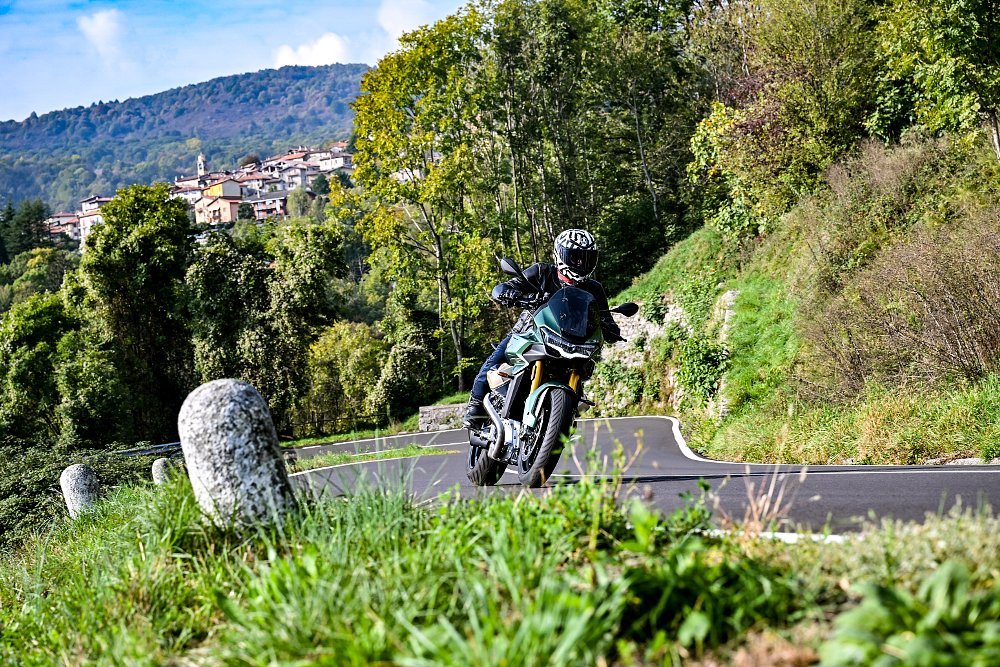
2021-2121: The next century of Moto Guzzi
While riding the V100 Mandello around Moto Guzzi's home turf, the bike remained impressive and enjoyable at every turn. Where was the Mandello concept 10 years ago? Better late than never, and I hope Moto Guzzi continues exploring new directions for its lineup.
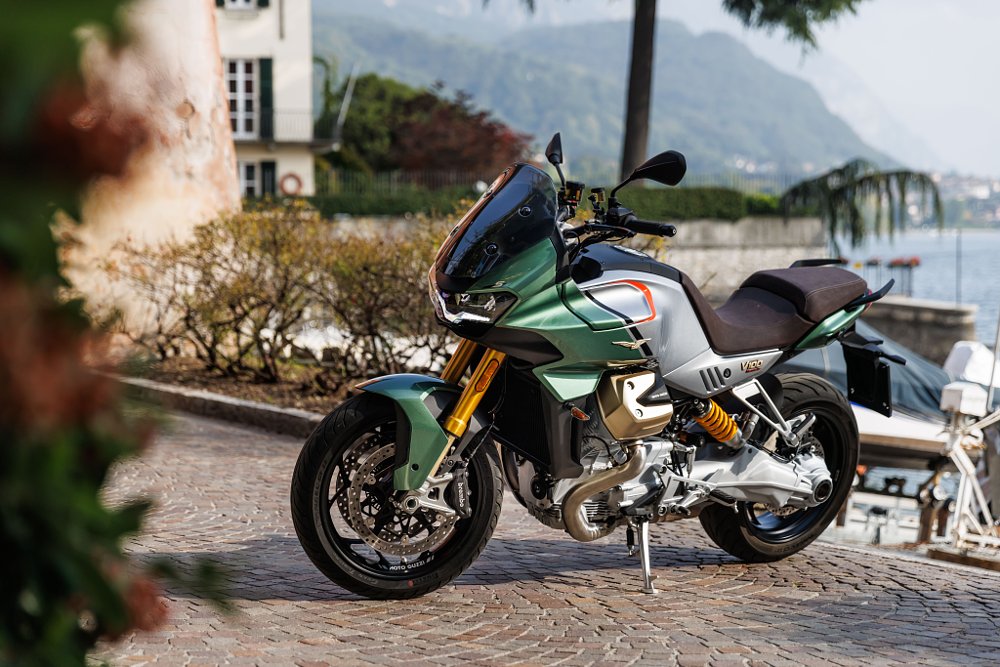
For me, there are three main takeaways from this first ride. First is the great success of the new engine. The "compact block" is a winner and I look forward to seeing it in more new Guzzis. Second, the Mandello shows that the sport-touring class deserves more attention. Innovations like adaptive aero are interesting, but the Mandello doesn't even need it to be competitive in the class. Outside the sport-ADV trend, modern motorcyclists are starved for dynamic, powerful, and versatile motorcycles that are ready to tour straight from the factory. And third? Moto Guzzi isn't leaning on old engines and bold new graphics anymore. This is the second consecutive model from the brand that surprised the jaded motorcycle world. The Mandello is a clean-sheet design that also brings the trademark transverse V up to modern standards, and that's quite a feat for a deeply traditional brand.
The 2023 Moto Guzzi V100 Mandello is available in Bianco Polare or Rosso Magma. The V100 Mandello S comes in Verde 2121 or Grigio Avanguardia. All versions should be available in U.S. dealers starting December 2022.
| 2023 Moto Guzzi V100 Mandello | 2023 Moto Guzzi V100 Mandello S | |
|---|---|---|
| Price (MSRP) | $15,490 | $17,490 |
| Engine | 1,042 cc, liquid-cooled, 4-valve, transverse V-twin | 1,042 cc, liquid-cooled, 4-valve, transverse V-twin |
|
Transmission, final drive |
Six-speed, shaft | Six-speed, shaft |
| Claimed horsepower | 115 @ 8,700 rpm | 115 @ 8,700 rpm |
| Claimed torque | 77.5 foot-pounds @ 6,750 rpm | 77.5 foot-pounds @ 6,750 rpm |
| Frame | Steel tubular | Steel tubular |
| Front suspension | 41 mm fork, adjustable for preload and rebound; 5.1 inches of travel | Öhlins NIX Smart EC 2.0 semi-active 43 mm fork, fully adjustable; 5.1 inches of travel |
| Rear suspension | Monoshock, adjustable for preload and rebound; 5.1 inches of travel | Öhlins TTX Smart EC 2.0 semi-active monoshock, fully adjustable; 5.1 inches of travel |
| Front brake | Dual Brembo four-piston calipers, 320 mm discs, ABS | Dual Brembo four-piston calipers, 320 mm discs, ABS |
| Rear brake | Brembo two-piston caliper, 280 mm disc, ABS | Brembo two-piston caliper, 280 mm disc, ABS |
| Rake, trail | 24.7 degrees, 4.1 inches | 24.7 degrees, 4.1 inches |
| Wheelbase | 58.1 inches | 58.1 inches |
| Seat height | 32.1 inches (31.5-inch low seat and 32.9-inch high seat available) | 32.1 inches (31.5-inch low seat and 32.9-inch high seat available) |
| Fuel capacity | 4.5 gallons (0.9 gallon reserve) | 4.5 gallons (0.9 gallon reserve) |
| Tires | Pirelli Angel GT II, 120/70R17 front, 190/55R17 rear | Pirelli Angel GT II, 120/70R17 front, 190/55R17 rear |
| Claimed weight | 514 pounds (claimed, wet, tank 90% full) | 514 pounds (claimed, wet, tank 90% full) |
| Available | December 2022 | December 2022 |
| Warranty | 24 months | 24 months |
| More info | motoguzzi.com | motoguzzi.com |





